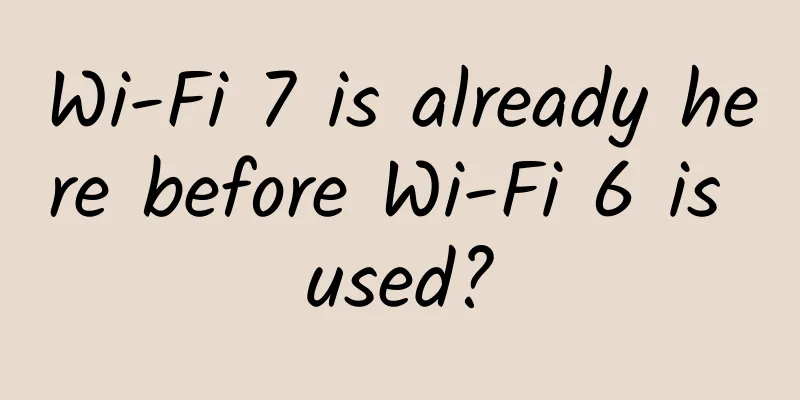Wi-Fi 7 is already here before Wi-Fi 6 is used?

|
On April 19, although Wi-Fi 6 is being widely popularized and it has become a consensus that many new 5G products support the Wi-Fi 6 protocol, there is still a long way to go before Wi-Fi 6 can be actually popularized. Recently, some media reported that the seventh-generation Wi-Fi 7 technology has been arranged, and it is said that the maximum speed of Wi-Fi 7 can reach 30Gbps. Users who are familiar with Wi-Fi 6 may know that its main improvement is that its QAM modulation accuracy is doubled, making the network speed of a single device faster, and the introduction of OFDMA technology can accommodate more device connections; in addition, Wi-Fi 6 also introduces BSS coloring technology, which can reduce signal interference between routers. At the same time, since the protocol introduces a target wake-up time design, Wi-Fi power consumption can be reduced. Compared with the Wi-Fi 5 routers currently used by most households, the maximum potential speed of Wi-Fi 6 will be 40% higher than the former, greatly improving the data transmission speed. The most likely protocol to become Wi-Fi 7 is the IEEE 802.11be standard that is currently under development. Compared to Wi-Fi 6 (802.11ax), Wi-Fi 7 is expected to have the following improvements: 1. Wi-Fi 7 will support 16 data streams. Supporting more data streams will also bring more powerful features such as CMU-MIMO. 2. Wi-Fi 7 also introduces a new 6GHz band, and three bands work simultaneously. In addition to the 2.4GHz and 5GHz bands, a new 6GHz band will also be introduced. 3. Wi-Fi 7 upgrades the signal modulation method to 4096QAM to have a larger data capacity. Wireless technology will of course involve the modulation method of the signal. In 802.11ax, the standard uses 1024-QAM modulation, and Wi-Fi 7 is expected to continue to upgrade the modulation method and directly use 4096-QAM to further expand the transmission data capacity and lay a solid foundation for the highest 30Gbps. With the arrival of Wi-Fi 7, the transmission speed can reach 30Gbps, which will bring users a smoother and faster transmission experience. Because it has a larger coverage area and effectively reduces transmission congestion, it will more effectively promote the popularization of 8K products. In other words, 8K video playback will no longer be a fantasy. |
<<: How to unleash greater potential of new infrastructure
>>: HTTP interview, 99% of interviewers like to ask these questions
Recommend
Dataideas: $1.5/month KVM-1GB/10G SSD/unlimited data/Houston (Texas)
Dataideas is a foreign VPS hosting company establ...
Huawei releases next-generation O&M architecture for autonomous network operation, expected to save operators 25% of O&M costs
On April 17, 2019, at HAS2019, Huawei released th...
Digital transformation has led to a surge in the number of emerging application services
January 17, 2018? F5 Networks (NASDAQ: FFIV) toda...
Summary information: Jinfeng Cloud/51 Point Quality Cloud/Yuan Cloud/Xin Tianyu Interconnection
The annual Double Eleven is also an online and of...
5G commercial use will be completed in one year, and the survey found that most consumers are still waiting and watching
Recently, Ms. He, a citizen, has frequently recei...
Current status of 5G development: In addition to the "fast Internet speed" in the eyes of ordinary people, what other development prospects are there?
When it comes to 5G, people don’t know much abou...
5G is here: Will 4G soon be relegated to the sidelines?
Will 4G, which once brought prosperity to the mob...
National Day promotion: CUBECLOUD 30% off/Olu Cloud VPS 20% off/Asia Cloud 20% off/Varidata Hong Kong Cloud Server 50% off
73 years of prosperity, building dreams of thousa...
Do you know the functions of these interfaces on the monitor?
From the previous CRT monitors to the current LCD...
Why do 5G mobile phones support more frequency bands?
How many 5G frequency bands a mobile phone can su...
2.4G or 5G? Do you know the difference between Wi-Fi frequency bands?
Overview The 2.4G and 5G mentioned in the title r...
Five-minute technical talk | A brief analysis of the generation strategy and application scenarios of distributed UUID
Part 01 What is UUID UUID stands for Universal Un...
Is Matter worth the wait?
An ambitious new smart home networking standard i...
ERROR 1273 (HY000): Unknown collation: 'utf8mb4_unicode_520_ci'
Today, when importing a MySQL database, I encount...
Interpretation of China's first LTE IoT multi-mode field test: Industry chain collaboration resolves the long-tail fragmentation problem
Recently, Qualcomm has cooperated with China Mobi...









